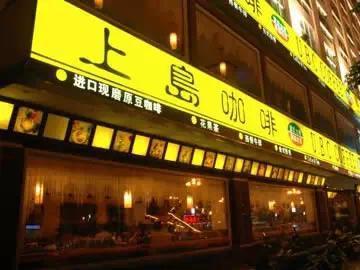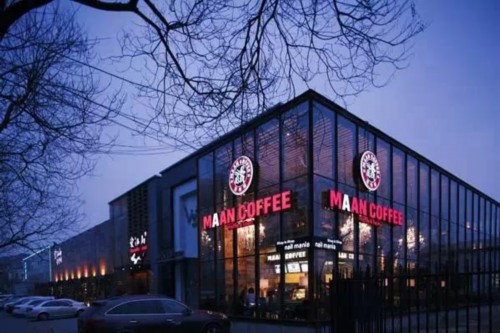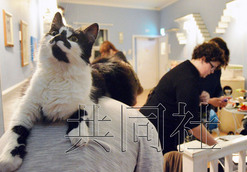Why is there a way out for cafes that "don't do their job"?
In China, a country with no history of coffee and no rigid demand for coffee, the shape of cafes is constantly evolving, spelling out more than just the quality of coffee.
Since French Godfather Tian Deneng moved the first coffee tree to China in 1902, coffee has experienced more than a hundred years of development in the Chinese market. From the coffee wasteland where coffee giants used to stay away, it is now regarded as one of the most valued markets by Starbucks, Costa and other brands.
In fact, cafes have made great achievements in the course of commercialization in China: the annual consumption of coffee is about 200000 tons, the number of cafes has long exceeded one million, and the entire coffee shop market is valued at nearly a trillion US dollars. it has overtaken the United States to become the world's largest coffee market.
On the road of continuous adaptation and development of the Chinese market, the shape of cafes continues to evolve. In fact, in a country where there is no history of coffee and no rigid demand for coffee, cafes are not just about the quality of coffee.
Coffee + catering mix: Shangdao Coffee

If we want to talk about the "mutation" history of coffee in China, we have to start with Shangdao.
The pioneer of serving the first cup of coffee for many Chinese is, in a sense, not a simple coffee shop. In fact, it is more appropriate to define its business model as a "hybrid restaurant".
In 1997, Shangdao was established in Hainan. Its founder, Chen Wenmin, is well aware that in China, where the public is not used to the bitter drink of coffee, the promotion of coffee alone is likely to fail. After months of market investigation, we specially make a brand-new business attempt on customer consumption pattern: mash-up!
On the island's menu, American hamburgers, spaghetti, Mexican steak, Yangzhou fried rice and other delicacies from all over the world can be found. In addition to coffee, there are Tieguanyin, grapefruit tea, juice and other drinks for customers to choose. It not only satisfies the conservatives who eat Chinese food, but also gets rid of the open school who likes to taste fresh.
This pattern also appears in other aspects of the island.
Shangdao has set up private rooms in the store, with mahjong tables, sofas, home theaters and other equipment for customers to relax after meals. The place is elegant, and you can eat and entertain both. This brand-new model is quickly recognized by young consumers. All of a sudden, Shangdao coffee quickly became popular all over the country.
After becoming popular, Shangdao did not forget the coffee itself. Whenever the waiter orders for the guests, they will recommend several types of coffee appropriately, so as to let the customers try and accept the drink unwittingly.
The effect of this kind of warm boiled frog is obvious. Under the imperceptible influence of Shangdao, more and more customers like coffee. Even when a new coffee product is launched on the island, many guests come to taste it.
At this time, the island continues to offer "mash-up" tricks, with coffee as the main meal to match the corresponding meals. In this mode in which coffee and meals influence each other, Shangdao's performance has gone crazy, reaching an impressive scale of 3000 stores across the country at its peak.
But surprisingly, this model with Chinese characteristics has only been popular for more than a decade.
On the one hand, in order to lay out the whole country, Shangdao divided the domestic market into eight regions, and under the leadership of various shareholders, created many sub-brands, including Milo, cross-strait and other sub-brands, and began to fight for the market with a new attitude.
Although the rise of sub-brands has largely contributed to the rapid expansion of Shangdao, it has occupied the commercial center of almost all the first-and second-tier cities in the country. However, these brands born on the island are very similar in terms of decoration style and business model, which leads to more and more homogenized competition in the development. In the end, it not only distracts the attention of the parent brand, but also makes consumers lose interest in the island because of the sameness of style.
On the other hand, with the change of customers' consumption habits, the supporting system that used to support Shangdao catering model gradually began to fall short of its ambition.
In order to save money, each store has only one chef who knows how to make each meal on the menu. Such a comprehensive chef is not common. Fortunately, Shangdao has a complete staff training system, and a skilled Chinese chef can become a head chef after more than two months of study.
In the blink of an eye for more than ten years, the market initiative of the coffee shop industry has already changed from the seller to the buyer's market. Consumers are no longer satisfied with one-stop consumption, and the integrated business model is regarded as "unprofessional". Customers with spending power are more likely to go to Starbucks for coffee, Pizza Hut to eat pizza and happy to sing.
In addition, as young people's career expectations change, it is difficult to find chefs who can adapt to the intensity of the company's work, and the talent supply crisis has made the high-quality service originally advertised on the island exist in name only.
The tired Shangdao was soon abandoned by customers, and those coffee lovers who were initially enlightened on the island have been dispersed to professional cafes, and now Shangdao has been reduced to a "place to eat small fried meat from farmers."
Coffee + "home": diffuse coffee

Shangdao left the market sadly, but the Chinese coffee market is becoming more and more popular. This piece of fertile soil is coveted by countless newcomers. Soon, a new model of cafes was born.
Since entering the Chinese market in 2010, Korean brand Man Coffee has defined the service concept as creating a "home" atmosphere for customers. The pursuit of "return to this doctrine" has made it choose a different path from its predecessors in many industries, such as Shangdao and Starbucks.
Unlike Starbucks, which focuses on coffee, Man Coffee is more willing to work on user experience and environment. In Starbucks, guests always feel the crowds, noisy environment, humble paper cups and stiff seats. In order to receive more guests, Starbucks wants customers to leave as soon as possible after buying coffee. Although this style is in line with the current fast-paced life style of white-collar workers, in fact, it deviates from the original intention that cafes should give guests leisure experience.
On the other hand, Man Coffee prefers to set up shop in quiet shops on the back street. On the one hand, the rents of shops on the back street are low, which can save property costs; second, at least three walls of the storefront at the end can be made into floor-to-ceiling windows, making the cafe look brighter during the day, and satisfy more customers' preference to sit by the window. and passers-by can get a clear view of the environment in the coffee from outside the window.
Generally speaking, most of the locations of Man Coffee are 300 square meters and 500 square meters. In order to create a staggered sense of space, designers not only decorate with compartments and gorgeous chandeliers, but even move thick tree trunks directly into the store, while rough concrete walls and wall-covered pipes are directly exposed in the hall. The strong sense of conflict formed by wood, reinforced concrete and chandeliers is refreshing to customers.
In addition to the fashionable decoration, Man Coffee is more concerned about the guests can feel the "home" atmosphere in the store. For this reason, the coffee is separated by standing lights and potted plants between every seat in the shop, giving guests the most private space. At the same time, Man Coffee also abandoned the traditional wooden chairs and paper cups, and spent a lot of money on soft sofas and textured mugs to give guests a more comfortable experience.
Interestingly, in order to prevent customers from getting bored while waiting, the coffee cashier will hand out cloth bears of a specific color to the customers, and then send the products to the buyers according to the color of the bears. Such a humanized design not only solves the problem that it is difficult to pay attention to every customer because the store is too large, but also helps customers to pass the boring waiting time.
Although there are a large number of tables for coffee, it does not expect to increase turnover by turning over. At the same time, even if consumers' behavior of drinking coffee has become widespread, coffee is still not a daily rigid demand, and it is not realistic to rely solely on selling coffee to get back the money. So the coffee also adds dim sum to the meals served by the cafe. But coincidentally, it makes a compromise between Shangdao and Starbucks, selling only some Western-style fast food, such as muffins and sandwiches, which can be made in a short time and can be copied quickly.
This kind of kitchen for making meals is open. The kitchen is usually located behind the counter facing the front door in the store, and whenever customers approach the coffee, they have the courage to enter the homes of old friends who are decorated in the western style. The food production process that is directly exposed in the eyes of customers makes them feel at ease.
It can not be ignored that, compared with coffee, pastry is more profitable, and it does become the bulk of the profit of diffuse coffee.
Coffee + Social Network: the Beast Garden
Before Chongqing established its first Beast Garden, Huang Feng did not have much confidence to pry up the coffee market.
If you use the same pattern to locate the same group of people, this mode of picking up wisdom is too dangerous. There is only one path to success: breakthrough and deduction to achieve innovation.
After several thoughts, Huang Feng found the breakthrough point of the Beast Garden-"novelty" and "Internet thinking". If you want to succeed in this era when the Internet is king, you must also integrate yourself into the Internet in addition to the novelty of the hardware.
In order to embody the theme of "Beast Garden", Huang Feng moved all the desert cactus and potted plants taller than people into the store, and then placed eye-catching rhino sculptures, so that every guest entering the store had a feeling of entering a different dimensional space.
After the hardware achieved the sensory novelty effect, Huang Feng focused on the Internet.
In Huang Feng's plan, the first step in the application of the Internet to the Beast Garden Cafe is to order food. After analyzing the behavior of young people who are used to playing with mobile phones, he launched the Wechat ordering model. Guests directly scan the QR code on the table, and then follow the prompts to enter the official Wechat account of the Beast Garden to select and place orders for a variety of coffee and meals.
This kind of coffee shop is still a rare ordering mode, which is not only in line with the behavior of young people today, but also saves a lot of labor costs for Beast Coffee. During the rush hour, Beast Garden does not need too many waiters to receive orders from more than a dozen guests at the same time.
In addition, this model can also have a deep understanding of customers' consumption habits. In September 2014, Huang Feng did an experiment. He asked the staff to screen out customers who had been absent for two months in a row and conduct targeted promotions so that they could get small gifts if they came to spend in the Beast Garden during the event.
The results showed that the attempt to bring more than 300 regular customers back to the Beast Garden also strengthened Huang Feng's determination to stick to the social network to the end.
In fact, in China's coffee shop market, the situation of one super and more powerful will not change in the short term. All kinds of emerging cafes are slowly eating away at the "big cakes" that used to belong to Starbucks. From its absolute dominance of 70% of china's market share in 2007 to 60% now, Starbucks has lost a lot in seven years.
The coffee shop guessed:
In the Chinese market, in addition to the "coffee plus" model, the basic lessons for opening a successful cafe are as follows:
1. The purpose of opening a coffee shop. This helps investors to build a correct understanding of cafes. For what purpose did you choose to open a coffee shop? Make money? Circle relationship? Or show taste?
2. Who is suitable for opening a coffee shop? The taste of the boss determines the success or failure of the cafe. Nowadays, Starbucks and other international chain brands produce enough coffee to meet the market demand, and it is difficult for private cafes to rely solely on the quality of coffee to attract customers. If you want to benefit from it, either your contacts are strong enough, or the cafe itself is distinctive enough.
3. Please pay attention to network marketing. Most private cafes are not in the commercial center. First, the property cost is too high, and on the other hand, most people with literary and artistic complex prefer quiet places behind the street. In order to make coffee shops popular, you must take the initiative to look for them on the Internet.
4. The orientation of coffee shop. This problem directly determines many factors, such as cafe input cost, decoration style, coffee grade, marketing strategy and so on. And opening a coffee shop in China is not just about selling coffee, it is very important to open your mind and imagine other possibilities of a coffee shop.
Those "unprofessional" cafes:
Coffee + teahouse: green
Tender Green is the first brand in China to standardize and fashion tea. It follows the Starbucks model, focusing on the mid-market of tea. For example: simple decoration style, VI system using green tone, simplified tea-making methods, and so on. In addition, an innovation has been made in the tea drink, adding fruit to the tea leaves, which not only tastes healthy but also makes the taste better.
Coffee + five-star roaster: 85C
Taiwan coffee shop brand 85C, while popularizing to consumers that the best water temperature for brewing coffee should be 85 ℃, while inviting roasters from five-star hotels to make cakes on the spot. At the same time, 85C mainly focuses on the low price strategy, and the price of a cup of coffee is only half that of Starbucks. This people-friendly model gives it a better market share than Starbucks in Taiwan.
Coffee + Lab: water molecule Cafe
The cafe, located in New York, USA, displays a variety of nutrients in transparent glass showcases. Surprisingly, this shop doesn't sell coffee at all. Customers call the drinks here "energy water": $2.50 for a beautiful glass bottle that can be taken away, and $1 for each vitamin added. The alternative style makes the store a must for tourists from all over the world to visit New York.
Important Notice :
前街咖啡 FrontStreet Coffee has moved to new addredd:
FrontStreet Coffee Address: 315,Donghua East Road,GuangZhou
Tel:020 38364473
- Prev

Cat Cafe becomes popular in Europe Japanese media say that "Origin" is in China.
According to Japan's Kyodo News Agency, the number of cat cafes that allow customers to play with their cats while enjoying black tea or coffee is increasing in Europe. The British media call the cat cafe a Japanese-style cafe, which is often understood as Japanese culture. It is reported that these cat cafes are mainly in Austria, Britain and the United Kingdom within two and a half years.
- Next

New Coffee drying equipment and Technology invented by Yunnan Lingfeng Group
Xinhua Yunnan Channel, February 17 (Reporter Ji Zhe Peng) in Yunnan, the largest coffee producing area in China, the lack of traditional coffee drying space and the decline in quality caused by cloudy and rainy weather restrict the initial processing of coffee. A few days ago, Lingfeng Group of Lincang City, Yunnan Province independently developed back-pressure hot air penetration auxiliary drying coffee technology and equipment, which realized the factory-oriented coffee processing.
Related
- Customers have "changed" Manner's new products! Shop assistant: Please don't mess around!
- Remove sockets in customer areas at Starbucks stores?! Netizen: I won't go if I really tear it down
- What is the difference between the taste steps of sun-dried coffee and washed coffee? Why is sun-cured coffee sweeter and washed coffee sour?
- The recipe for salty grapefruit dirty is revealed! Coffee Festival salty grapefruit dirty coffee making materials parameters ratio milk share!
- How about the flavor of Sunlight 74158 at Sidamo Banshaha Mathieu Processing Factory in Ethiopia? 74158 Share the proportion of coffee brewing parameters!
- What effect does Italian American coffee with filter paper have? Will coffee taste better if it is put on filter paper at the bottom of the powder bowl?
- What is the color difference in coffee beans? What are the characteristics of honey processed coffee beans? Why are the anaerobically treated coffee beans uneven in color?
- How does novice Xiaobai quickly get started and make coffee? Newbies learn to make coffee by hand and share the specific steps and process process!
- Costa tea has a shelf life of 100 years?! Expert: Unable to verify
- It's a huge uproar! American milk addition was rejected by Manner employees?!

